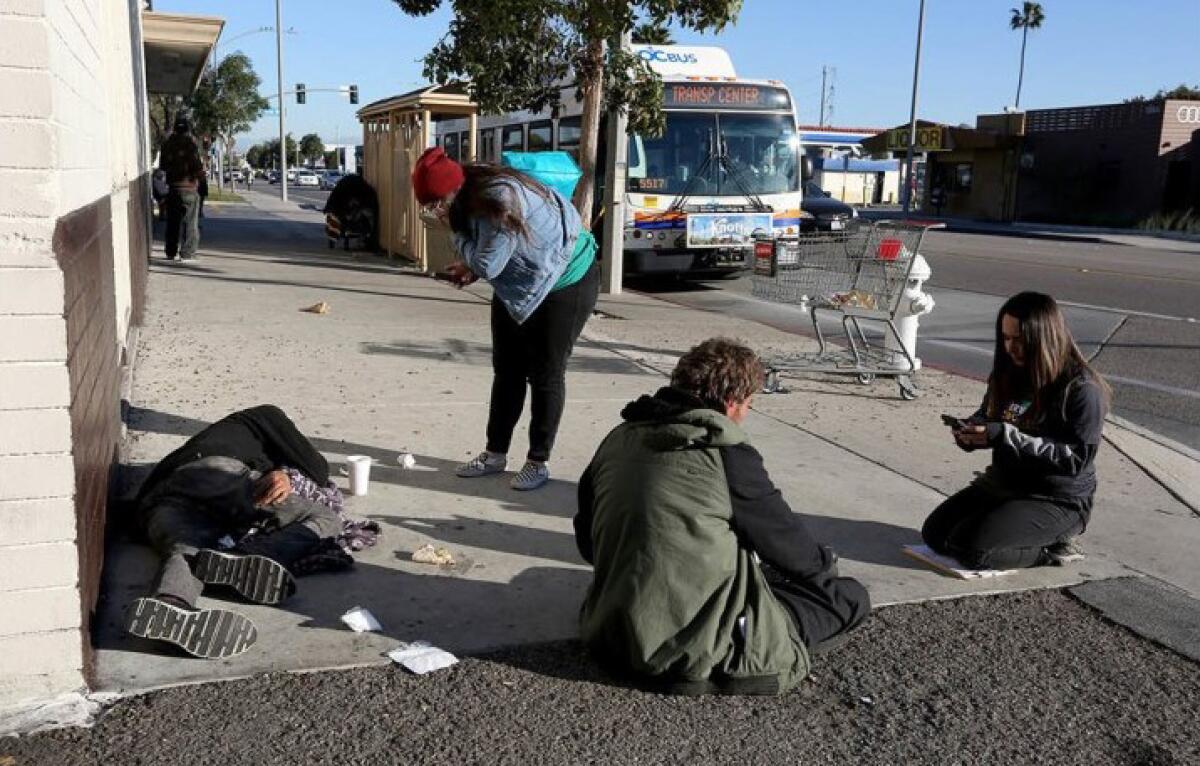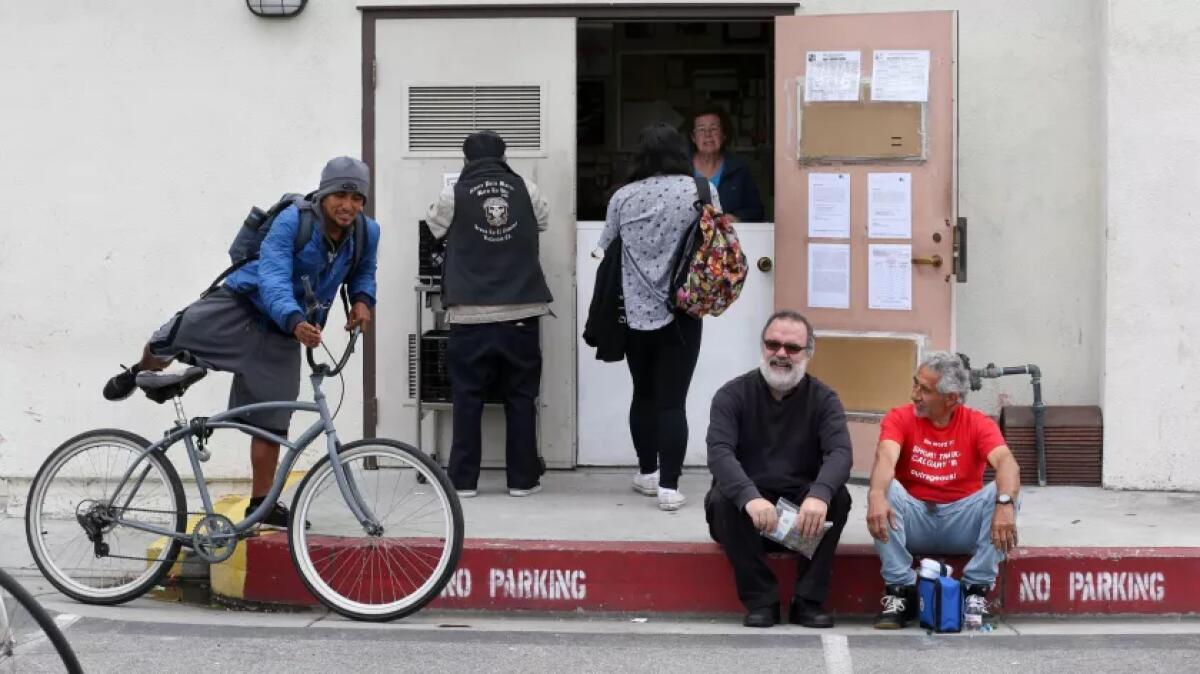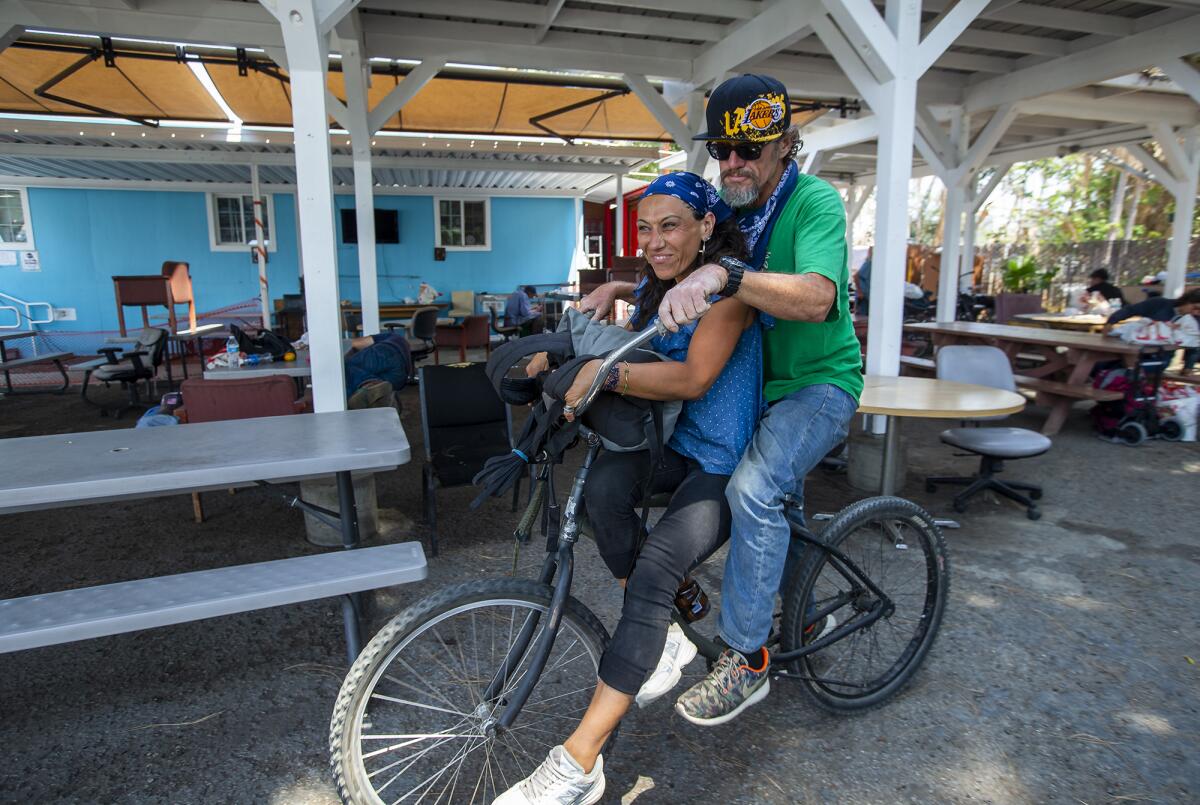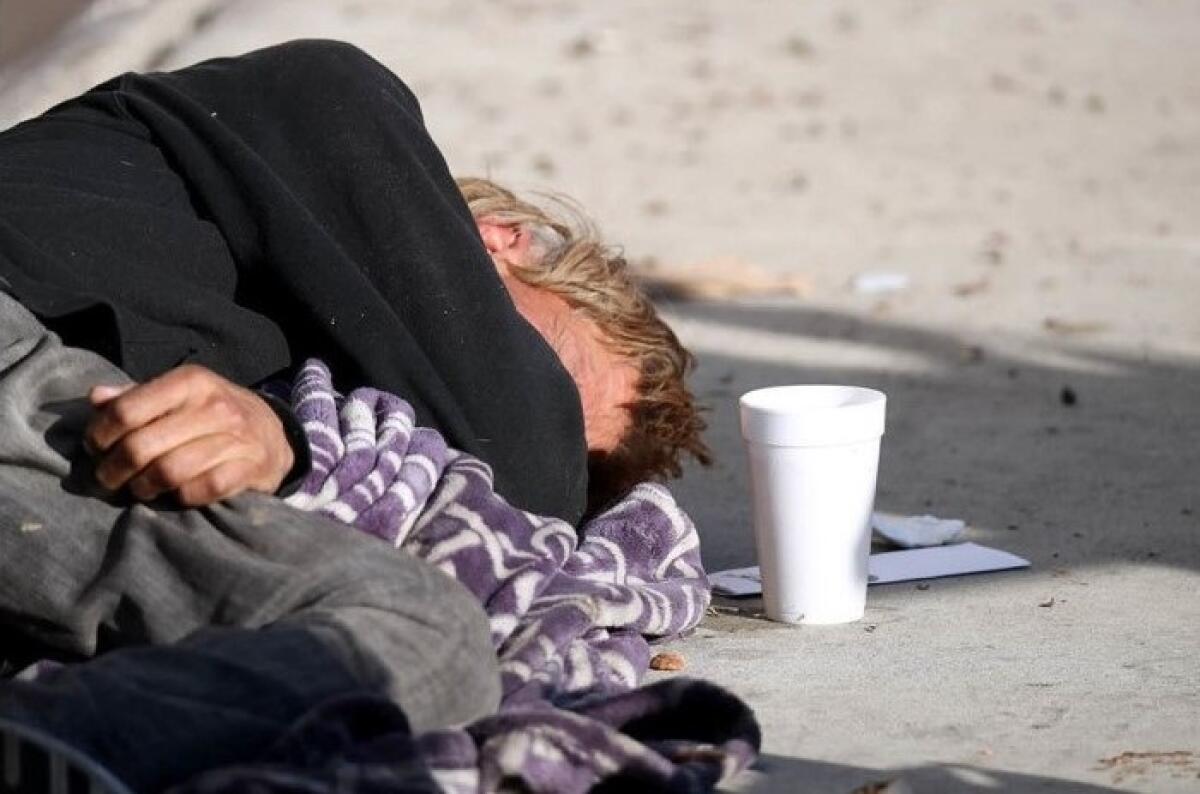Orange County on pace for most homeless deaths in its history, again

More homeless people will likely have died this year in Orange County than any other.
According to coroner’s data, at least 321 homeless people have died this year. The final death count will most likely exceed the 330 deaths from last year, which was the highest total in Orange County history according to the coroner’s office. Now, the county enters the colder months of the year, which homeless advocate Tim Houchen said are always the hardest for people living on the street.
The high death count shows how the last two years during the pandemic have been the hardest for Orange County’s homeless. In 2019, just over 200 homeless people died.
“It’s no surprise that people are continuing to die on the streets at record numbers,” said Brooke Weitzman, an attorney and homeless advocate. “We have an aging unhoused population, we have more seniors than ever flowing into homelessness, we have, of course, a global pandemic. That has some impact, both in terms of people who may have had their health impacted by COVID, but also in terms of available resources.”
Many of the deaths on the coroner’s report were caused by drug overdoses, with 106 of them involving the powerful synthetic drug fentanyl. Eighteen of the deaths were caused by COVID-19. Others died from traffic injuries, suicides, homicides and other health issues. Nearly 80 of the cases are still pending a cause of death. The oldest pending death is from June 21.
The answer to homelessness, the rise in deaths and cure for the drug issues is clear to homeless advocates: house the homeless.
“It really doesn’t take much to understand that if you’re sleeping on the street, you’re not taking a shower, you’re being visited by a number of people like the police telling you to move along pretty much on a daily basis ... between the simultaneous boredom and the stress, it’s a virtual prescription for drugs and self-medication,” said Father Dennis Kriz, a local homeless advocate and pastor of a Fullerton church.
Removing the stress by putting a roof over somebody’s head will help solve the drug issue, said Kriz, who provides monthly reports on homeless deaths for the Voice of OC.
Weitzman said that an abundance of research shows that people struggling with substance abuse are not able to address their issues until they have a home. She said the current structure in the county takes far too long to help homeless people struggling with substance abuse disorders.
“If we’re going to get ahead of this thing, we need to take drastic action quickly to increase the available housing,” Weitzman said. “Whether that’s converting empty motels and hotels or approving more projects for development, there’s any number of paths we can take to get there. But the system that we have relied upon in the past of kind of slowly developing a congregate shelter in a city once every couple of years, hoping that maybe people will pass through it to get to housing, it isn’t working. It isn’t enough.”

Weitzman also said that cities should be opening resources like Mary’s Kitchen, a nonprofit in Orange that provides a number of services to hundreds of homeless people, including three meals, six days a week. The city has been trying to shut down the nonprofit for the last few months, but Mary’s Kitchen has been fighting the effort in court. Weitzman is representing the nonprofit.
Advocates have been concerned about a rise in homeless deaths since the early months of the pandemic. Kriz and other activists held car rallies to call on Orange County to do more for its homeless residents. During the pandemic, the county focused on rolling out Project Roomkey, a statewide program that temporarily placed the homeless in hotel rooms, and Project Homekey, another state initiative that entails purchasing and rehabilitating hotels, motels, vacant apartments and other buildings to house the homeless. Homeless advocates likened the hotels and shelters to being run like prisons.
Houchen said homeless people reported feeling “isolated” and “confined” staying in Project Roomkey hotels. Kriz called the program “voluntary incarceration” due to the quarantine restrictions placed on homeless people.
Weitzman said Project Homekey has so far not served enough people, with just 132 rooms provided by the Stanton hotel and motel it purchased. The county had almost 7,000 homeless people during the 2019 Point in Time count, which was the most recent. Weitzman said there has probably been a 20% to 30% increase in those numbers over the last few years with the economic downturn from the pandemic.
“Given the amount of state and federal money flowing into that program, we have to ask, why is it only in one city?” Weitzman said. “Why didn’t Orange County jump on the opportunity to get sites in every city that had an available building?”
Kriz echoed Weitzman’s sentiments about Homekey.
“It’s nothing near what is needed,” Kriz said.
Kriz said that even if a person living on the street were willing to take part in one of the county programs, it was difficult for them to be placed. The people who were largely able to take advantage of those programs were already in shelters, he said.
“So if you’re outdoors at the beginning of COVID, that’s where you were, that’s where you are, and that’s where a lot of people died,” Kriz said.

Douglas Becht, acting director of the county’s Office of Care Coordination, described in an emailed comment all that the county has done for the homeless during the pandemic. In addition to Roomkey and Homekey, the county also started a Project Toolbelt program, which was used to transfer Project Roomkey participants to next step housing options. Becht also said that the county is working with public housing authorities to hand out more than 1,000 housing vouchers.
Weitzman said the voucher number is also low considering how many homeless people are in the county. She also said a voucher doesn’t ensure that somebody will be easily housed. Individuals have to find a landlord who will accept the voucher, which is becoming increasingly difficult in Orange County.
“It is becoming harder and harder to find rentals in Orange County,” Weitzman said. “The rental market has a very low vacancy right now, at least in the lower end.”
Becht also mentioned the county’s opening of the Yale homeless shelter in Santa Ana earlier this year.
“The County of Orange continues to work with state and local public health services on the implementation of COVID-19 guidance and protocols for emergency shelters including but not limited to following social distance guidance for sleeping and communal areas, cleaning protocols, installing physical barriers and providing Food and Drug Administration approved personal protective equipment for staff and program participants,” Becht said. “In addition, COVID-19 testing and vaccines are available for all program participants and staff, and will be available on an ongoing basis. The goal is to promote vaccinations among this community and to ensure precautions are taken to safeguard against the spread of COVID-19.”
Houchen said many of the homeless die on the street because they don’t want to go to a shelter. Several homeless shelters have opened in the last couple of years in Orange County in response to a landmark lawsuit filed in 2018 by Weitzman’s firm, Elder Law and Disability Rights (ELDR) Center, in an attempt to prevent the county from clearing a homeless encampment near the Santa Ana River.
Government officials and others tend to call these kinds of homeless people “service resistant.” But, as Houchen points out, there’s good reason for them to resist going to shelters in Orange County. Homeless shelters in the county have faced COVID-19 outbreaks and a lawsuit for sexual harassment and inhumane conditions.
Houchen said that products and services are generally tailored to the desires of consumers, except in the case of the homeless, who are regularly presented with substandard services. Then when they reject these services, they are termed “service resistant,” Houchen said.
Houchen said the shelters need to be more trauma-informed. According to the National Coalition for the Homeless, this emphasizes “understanding, compassion and responding to the effects of all types of trauma.”
“We need to reform our shelters because nobody wants to go to them,” Houchen said. “... Once we start providing services and facilities that are acceptable to these folks, then we can expect them to take advantage.”
Houchen mentioned that when he was homeless he disliked staying in congregate shelters in the winter because it would almost guarantee catching an illness.
“Having personally lived in shelters before, I could tell you when I was sitting there in the middle of winter at the armory, and there’s just people all around you, just within inches of you, and it seemed like half the people in there are coughing and sneezing,” Houchen said. “You have to wonder, what’s flying around the air in here? This was before there was COVID.”
Even if homeless individuals are hoping to enter a shelter, it can be difficult. Weitzman said you can’t walk into a shelter in Orange County, you have to be referred.
She said many cities use police for referrals, which can be a barrier for homeless people who view law enforcement as antagonistic.
“The more barriers that we create in our system to people getting access, the more we’re going to see people unable to gain access,” Weitzman said.
Another potential factor to the homeless death count could be the closure earlier this year of the county’s Courtyard shelter in Santa Ana, which was home to more than 400 people. While the shelter was heavily criticized for its living conditions, it was Orange County’s only walk-in shelter. The county opened its Yale shelter, which has more services but requires referrals and is more restrictive.
Santa Ana also closed its homeless shelter, the Link, earlier this year. It is supposed to be replaced by the city’s Carnegie Avenue shelter, which hasn’t yet opened. Possibly in response to the lack of shelter in the city, dozens of homeless people gathered in the parking lot of a Mexican cultural center during the pandemic.
“Santa Ana never should have closed its shelter without having a replacement online,” Kriz said.
Kriz and Houchen believe more homeless people have died than are included in the coroner’s data. In past years, Houchen added names to the coroner’s list of homeless people who died that he independently verified. Kriz said in the past he held a memorial service for a homeless person that wasn’t included on the list.
“Certainly the number is higher than what is listed,” Kriz said.

As the pandemic continues, Houchen said one of the major issues he’s focusing on is the lack of information the coroner’s office provides when a homeless person dies. He said he’s followed up on cases that were pending for more than a year without updates.
Weitzman said the county should be tracking important information, like how many contacts a deceased homeless person had with the healthcare system or with law enforcement. She said the county should be tracking this important data on each of the 300-plus homeless people who died in order to fix the gaps in the system.
“They need to supply us with the information but they don’t,” Houchen said. “They just give us very little information about folks out there on the streets. If they would give us more, then we might be able to be more proactive in saving lives ... This problem should have been stamped out before COVID, or at least there should have been some really good signs of progress. In my time, I’ve learned to take progress in small increments. But there’s never been any huge progress, as far as I can see, to eliminate or lower those numbers on the street.
“We haven’t learned anything from the past. Whether it’s COVID-related or not, there’s not enough care. Whether it be in a shelter or on the street, we’re not giving them the options that would be best for their health.”
All the latest on Orange County from Orange County.
Get our free TimesOC newsletter.
You may occasionally receive promotional content from the Daily Pilot.




